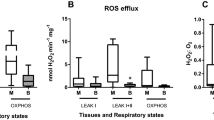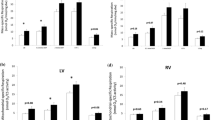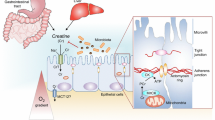Abstract
Mammalian lactate dehydrogenase and phosphofructokinase are more susceptible in vitro to superoxide\((O_2^{\dot - } )\) and hydroxyl (·OH) radicals than pyruvate kinase and glucose-6-phosphate dehydrogenase, suggesting that differential inactivation of regulatory enzymes contributes to the metabolic disintegration in stenoxic tissues during transient hypoxia. Like-wise, creatine kinase in smooth muscle from porcine ileum is significantly reduced by hypoxia-reoxygenation ex vivo from 300 (±18.2 SE,n=8) to 196 U·g wet wt-1 (±16.7,P0.001, ANOVA). Conversely, arginine kinase, from the myocardium ofLimulus polyphemus, a species that tolerates anoxia for days was 2.9-fold less susceptible to oxidative inactivation. To examine whether preservation of kinase function is related to euryoxic capacity, a combination of non-invasive31P-NMR spectroscopy and enzyme-linked assays was used to follow ATP and phosphagen status during hypoxia-reoxygenation in porcine ileum smooth muscle,L. polyphemus myocardium, and the myocardium ofArgopecten irradians, a scallop species tolerant of hypoxia for only 24 h. Despite wide differences in phylogeny, euryoxic capacity and oxidative vulnerability of the phosphagen kinases, in all three tissues, the phosphagen pool recovered concomitant with ATP during reoxygenation, thereby revealing competent kinase function. In the mammalian tissue, such preservation of kinase function is facilitated by a 2400-fold excess of enzyme activity.
Similar content being viewed by others
Abbreviations
- AK :
-
arginine kinase
- CK :
-
creatine kinase
- DTE :
-
dithioerythritol
- EDTA :
-
ethylenediaminetetra-acetic acid
- EGTA :
-
ethyleneglycol-bis (β-aminoethylether)N,N′-tetra-acetic acid
- G-6-PDH :
-
glucose-6-phosphate dehydrogenase
- LDH :
-
lactate dehydrogenase
- MOPS :
-
[3-morpholino]propanesulfonate
- NBT :
-
nitroblue tetrazolium
- NMR :
-
nuclear magnetic resonance
- PCr :
-
phosphocreatine
- PFK :
-
phosphofructokinase
- Pi :
-
inoganic phosphate
- PK :
-
pyruvate kinase
- PME :
-
phosphomonoester
- ppm :
-
parts per million
- SW :
-
sea water
- XOD :
-
bovine buttermilk xanthine oxidase
References
Ambrosio G, Zweier JL, Jacobus WE, Weisfeldt ML, Flaherty JT (1987) Improvement of postischemic myocardial function and metabolism induced by administration of desferoxamine at the time of reflow: the role of iron in the pathogenesis of reperfusion injury. Circulation 76: 906–915
Bolling SF, Bies LE, Bove EL, Gallagher KP (1990) Augmenting intracellular adenosine improves myocardial recovery. J Thorac Cardiovasc Surg 99: 469–474
Bücher T, Pfleiderer G (1955) Pyruvate kinase from muscle. In: Colowick SP, Kaplan NP (eds) Methods in enzymology. Academic Press, New York, pp 435–440
Bulkley GB (1983) The role of oxygen free radicals in human disease processes. Surgery 94: 407–411
Buxton GV, Greenstock CL, Helman WP, Ross AB (1988) Critical review of rate constants of aqueous electrons, hydrogen atoms and hydroxyl radicals (•OH/•O-) in aqueous solutions. J Phys Chem Res Data 17: 513–886
Clark ET, Gewertz BL (1992) Limiting oxygen delivery attenuates intestinal reperfusion injury. J Surg Res 53: 485–489
Clottes E, Couthon F, Denoroy L, Vial C (1994) Creatine kinase compactness and thiol accessibility during sodium dodecyl sulfate denaturation estimated by resonance energy transfer and 2-nitro-5-thiocyanobenzoic acid cleavage. Biochim Biophys Acta 14: 171–176
DeFur PL, Mangum CP (1979) The effects of environmental variables on the heart rates of invertebrates. Comp Biochem Physiol 62A: 283–294
Dykens, JA, Rogers J (1991) Creatinine and arginine kinase are selectively inactivated by superoxide radical exposure: implications for reoxygenation injury. Bull Mt Desert Isl Biol Lab 30: 16
Dykens JA, Shick JM (1988) Relevance of purine catabolism to hypoxia and recovery in euryoxic and stenoxic marine invertebrates, particularly bivalve molluscs. Comp Biochem Physiol 91C: 35–41
Dykens JA, Takayama MM, Wakai RH (1988) Purine catabolism and oxidative defenses inMytilus edulis andPlacopecten magellanicus: a model for mammalian reperfusion injury. Bull Mt Desert Isl Biol Lab 27: 101–102
Dykens JA, Joseph A, Deel S, Freiburger H (1991) Cyanide insensitive molluscan respiration and mitochondrial free radical production. Bull Mt Desert Isl Biol Lab 30: 102–103
Ellington RW (1983) Phosphorus nuclear magnetic resonance studies of energy metabolism in molluscan tissues: effect of anoxia and ischemia on the intracellular pH and high energy phosphates in the ventricle of the whelk,Busycon contrarium. J Comp Physiol 153: 159–166
Ellington RW (1989) The recovery from anaerobic metabolism in invertebrates. J Exp Zool 228: 431–444
Falkowski PG (1974) Facultative anaerobiosis inLimulus polyphemus: phosphoenolpyruvate carboxykinase and heart activities. Comp Biochem Physiol 49B: 749–759
Fridovich I (1985) Xanthine oxidase. In: Greenwald RA (ed)CRC handbook of methods for oxygen radical research, CRC Press, Boca Raton, pp 51–53
Fucci I, Oliver CN, Coon MJ, Stadtman ER (1983) Inactivation of key metabolic enzymes by mixed-function oxidation reaction: possible implication in protein turnover and aging. Proc Natl Acad Sci USA 80: 1521–1525
Furter R, Furter-Graves EM, Wallimann T (1993) Creatine kinase: the reactive cysteine is required for synergism but is nonessential for catalysis. Biochemistry 32: 7022–7029
Gäde G (1983) Energy metabolism of arthropods and mollusks during environmental and functional anaerobiosis. J Exp Zool 228: 415–429
Granger DN, Parks DA (1983) Role of oxygen radicals in the pathogenesis of intestinal ischemia. Physiologist 26: 159–164
Halliwell B, Gutteridge JMC (1989) Free radicals in biology and medicine, Clarendon Press, Oxford
Hochachka PW (1980) Living without oxygen. Harvard Univ Press, Cambridge, Mass
Ishida Y, Paul RJ (1989) Evidence for compartmentation of high energy phosphagens in smooth muscle. Prog Clin Biol Res 315: 417–428
Ishida Y, Paul RJ (1990) Effects of hypoxia on high-energy phosphagen content, energy metabolism and isometric force in guinea-pig taenia caeci. J Physiol (Lond) 424: 41–56
Kushmerick MJ (1983) Energetics of muscle contraction. In: Peachey LD, Adrian RH (eds) Handbook of physiology. Am Physiol Society, Bethesda, MD, USA, pp 189–236
Lin L, Perryman MB, Friedman D, Roberts R, Ma TS (1994) Determination of the catalytic site of creatine kinase by sitedirected mutagenesis. Biochim Biophys Acta 1206: 97–104
Ling KH, Paetkau V, Marcus F, Lardy HA (1966) Phosphofructokinase. In: Wood EA (ed) Methods in enzymology, vol IX. Academic Press, New York, pp 425–429
McCord JM (1985) Oxygen-derived free radicals in postischemic tissue injury. N Engl J Med 312: 159–163
McCord JM, Russell WJ (1988) In: Cerutti PA, Fridovich I, McCord JM (eds) Oxy-radicals in molecular biology and pathology. Alan Liss, New York, pp 27–35
Parks DA, Granger DN (1986) Role of oxygen radicals in gastrointestinal ischemia, In: Rotilio G (ed) Superoxide and superoxide dismutase in chemistry, biology and medicine, Elsevier, Amsterdam, pp 614–617
Parks DA, Bulkey GB, Granger DN (1983) Role of oxygen-derived free radicals in digestive tract diseases. Surgery 94: 415–422
Parks DA, Williams TK, Beckman JS (1987) Xanthine dehydrogenase to oxidase conversion in ischemic small intestine. Fed Proc 46: 1124
Sharma MK, Buettner GR, Spencer KT, Kerber RE (1994) Ascorbyl free radical as a real-time marker of free radical generation in briefly ischemic and reperfused hearts: an electron paramagnetic resonance study. Cire Res 74: 650–658
Sheikh S, Katiyar SS (1993) Chemical modification of octopine dehydrogenase by thiol specific reagents: evidence for the presence of an essential cysteine at the catalytic site. Biochim Biophys Acta 1202: 251–257
Shick JM, Widdows J, Gnaiger E (1988) Calorimetric studies of behavior, metabolism and energetics of sessile intertidal animals. Am Zool 28: 161–181
Stadtman ER, Oliver CN, Levine RL, Fucci L, Rivett AJ (1987) Implication of protein oxidation in turnover, aging and oxygen toxicity. In: Simic MG et al (eds) Oxygen radicals in biology and medicine. Plenum Press, New York, pp 331–339
Stadtman ER (1992) Protein oxidation and aging. Science 257: 1220–1224
Suzuki YJ, Edmondson JD, Ford GD (1992) Inactivation of rabbit muscle creatine kinase by hydrogen peroxide. Free Rad Res Comm 16: 131–136
Theede H, Ponat A, Hiroki K, Schlieper C (1969) Studies on the resistance of marine bottom invertebrates to oxygen-deficiency and hydrogen sulfide. Mar Biol 2: 325–337
Tyler DD (1975) Polarographic assay and intracellular distribution of superoxide dismutase in rat liver. Biochem J 147: 493–504
Wiseman RW, Ellington WR, Rosanske RC (1989) Effects of extracellular pH andd-lactate efflux on regulation of intracellular pH during isotonic contractions in a molluscan muscle: a31P-nuclear magnetic resonance study. J Exp Zool 252: 228–236
Wiseman RW, Ellington WR (1989) Intracellular buffering capacity in molluscan muscle: superfused muscle versus homogenates. Physiol Zool 62: 541–558
Worthington CC (1988) Worthington manual. Worthington Biochemical Co., Freehold, New Jersey
Wrogemann K, Stephens NL (1977) Oxidative phosphorylation in smooth muscle. In: Stephens NL (ed) The biochemistry of smooth muscle, University Park Press, Baltimore, MD
Yuan G, Kaneko M, Masuda H, Hon RB, Kobayashi A, Yamazaki N (1992) Decrease in heart mitochondrial creatine kinase activity due to oxygen free radicals. Biochim Biophys Acta 1140: 78–84
Author information
Authors and Affiliations
Additional information
Communicated by L.C.-H. Wang
Rights and permissions
About this article
Cite this article
Dykens, J.A., Wiseman, R.W. & Hardin, C.D. Preservation of phosphagen kinase function during transient hypoxia via enzyme abundance or resistance to oxidative inactivation. J Comp Physiol B 166, 359–368 (1996). https://doi.org/10.1007/BF02336918
Accepted:
Issue Date:
DOI: https://doi.org/10.1007/BF02336918




